|

Camellia Japonica was native to Japan in two
forms: the Yabutsubaki ヤブツバキ, a taller tree that
grows at lower and milder elevations, and the
Yukitsubaki ユキツバキ, a more prone tree found at
higher and colder elevations. At some point the
two types interbred to create what is known as
Yukibatatsubaki ユキバタツバキ. With the natural and
cultivated hybridization of these orginal stocks,
many forms of camellia flourished.
It must be mentioned there are two
other Camellia species, Camellia sinensis and
Camellia sasanqua. Camellia sinensis refers to the
plant from which tea leaves are obtained, any type
of black tea, green tea, and matcha. Camellia
sasanqua is a low bush, closely related to
sinensis. Due to the close relation, sasanqua are
avoided as tea flowers. They may be identified by
the fact that when their flowers fall, it is petal
by petal, whereas Camellia japonica flowers fall
as a unit.
In addition to the shape of buds and
blooms, and the coloration of the petals, features
of the stamens and the shape, color, and edge of
the leaves are distinct among cultivars. A few
examples are provided below.
STAMENS
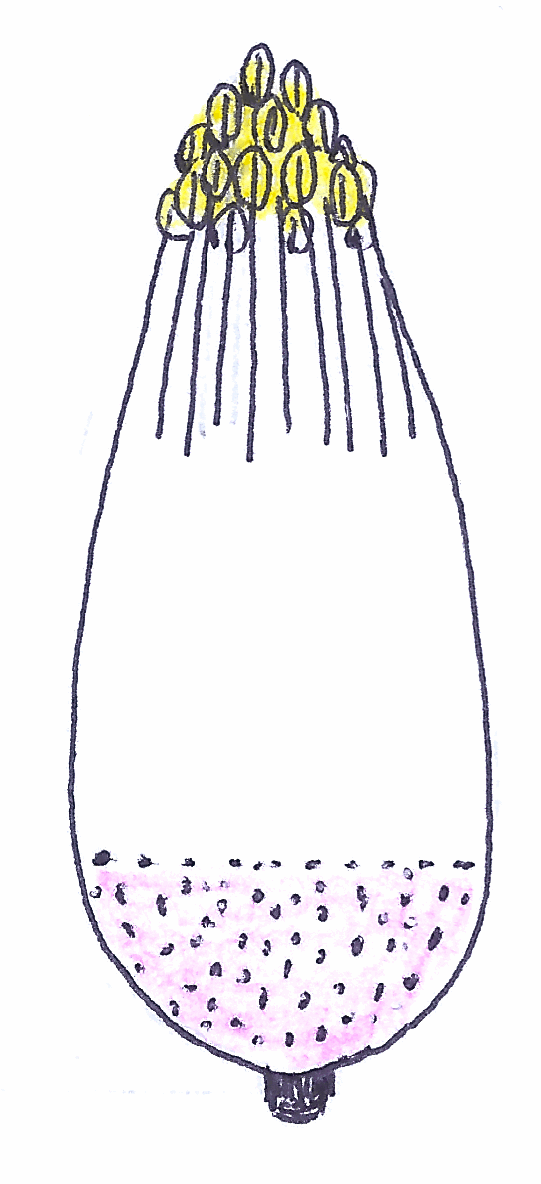
閉じ芯 Tojishin Closed Stamen
The anthers and filaments are tightly enclosed in
a pointed shape
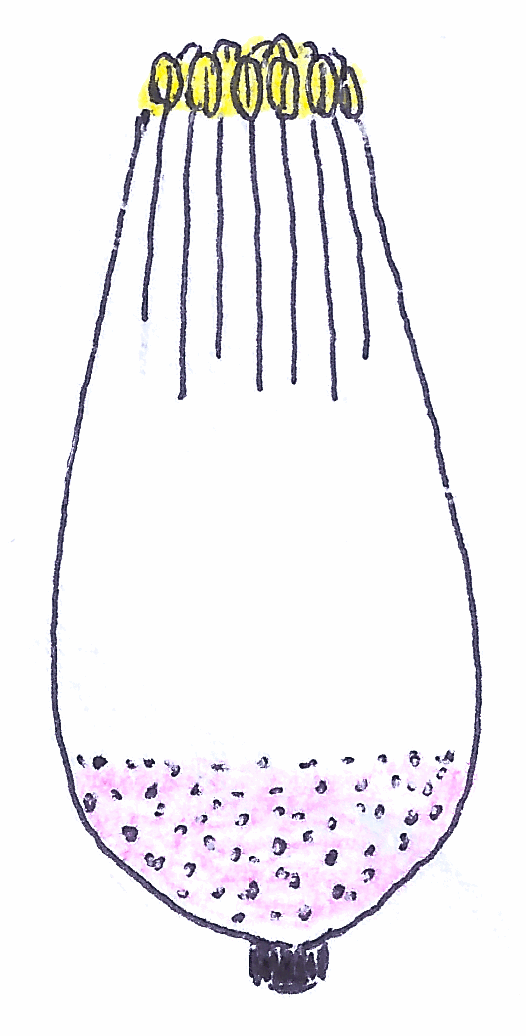
先細り Sakibosori Narrow Tip
The head of the stamen tapers. Found mostly in the
Yukitsubaki on the Tokai Eastern Seaboard. Only
about three cultivars display this kind of stamen,
which are called Tsumami [pinched] Yukitsubaki.
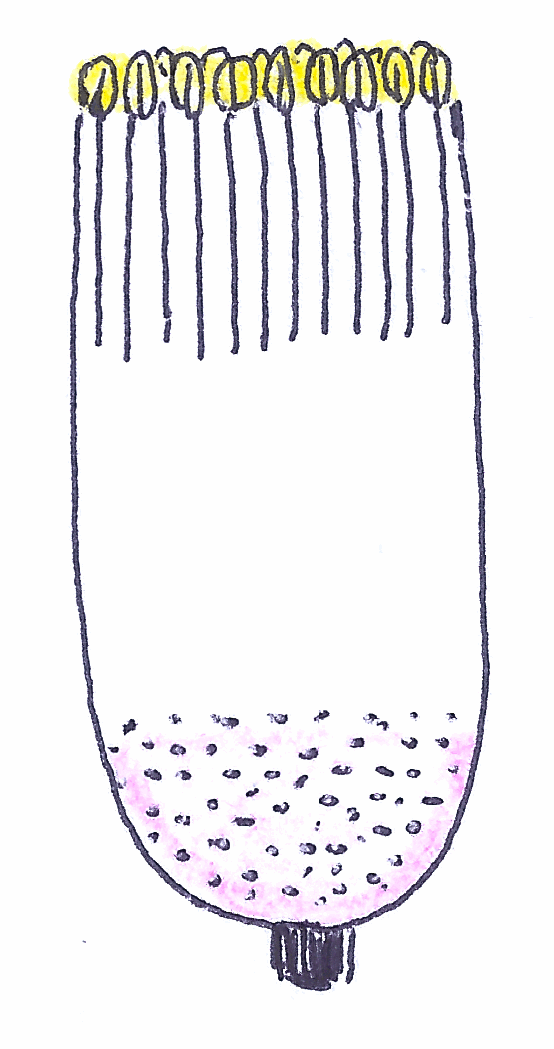
筒 Tsutsu Cylindrical
Regular diameter without variation. In this type,
if the stamens are pure white, they are much
appreciated.
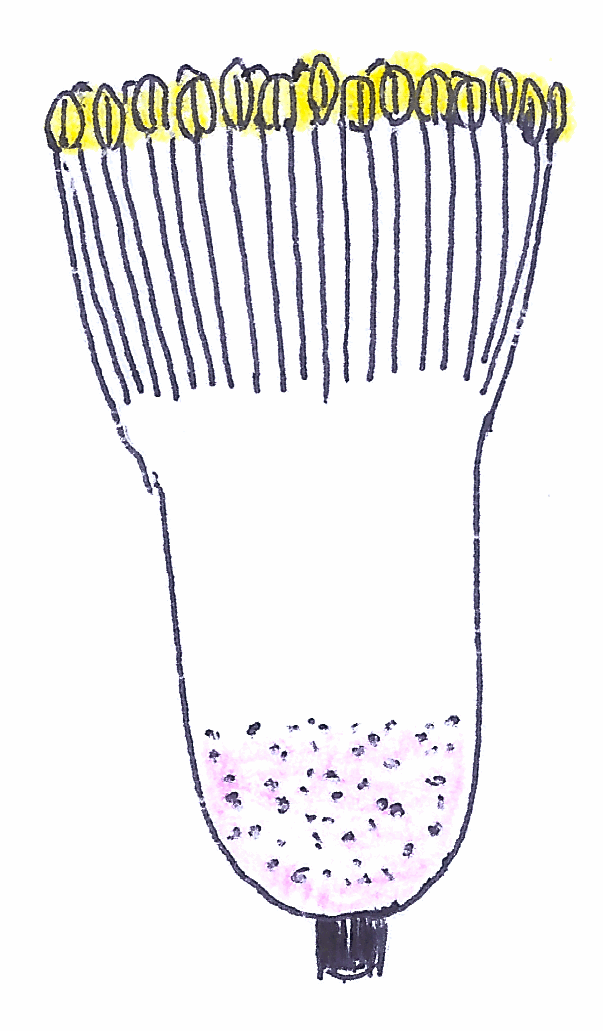
先太り Sakibutori Wide Tip
Variation on the tsutsu shape of stamen where the
head widens.
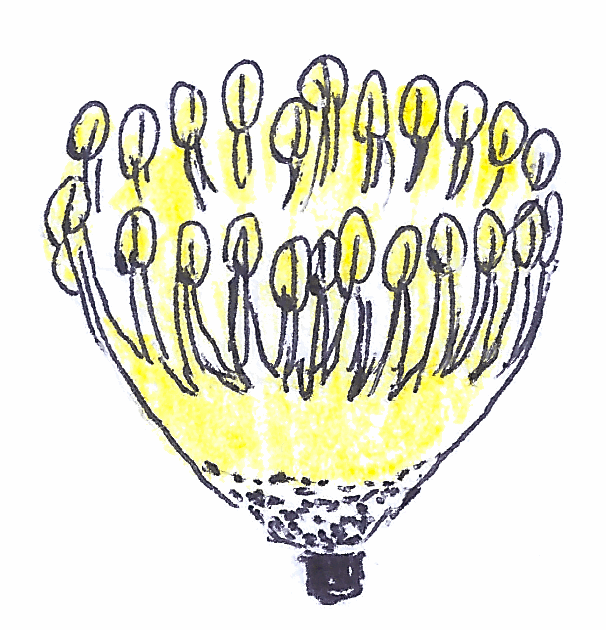 ユ
キ芯 Yukishin Snow Camellia Stamen ユ
キ芯 Yukishin Snow Camellia Stamen
Particular to the Yukitsubaki. The filaments are
very thin, and both filaments and anthers are a
deep yellow color. Both long and short filaments
mingle together.
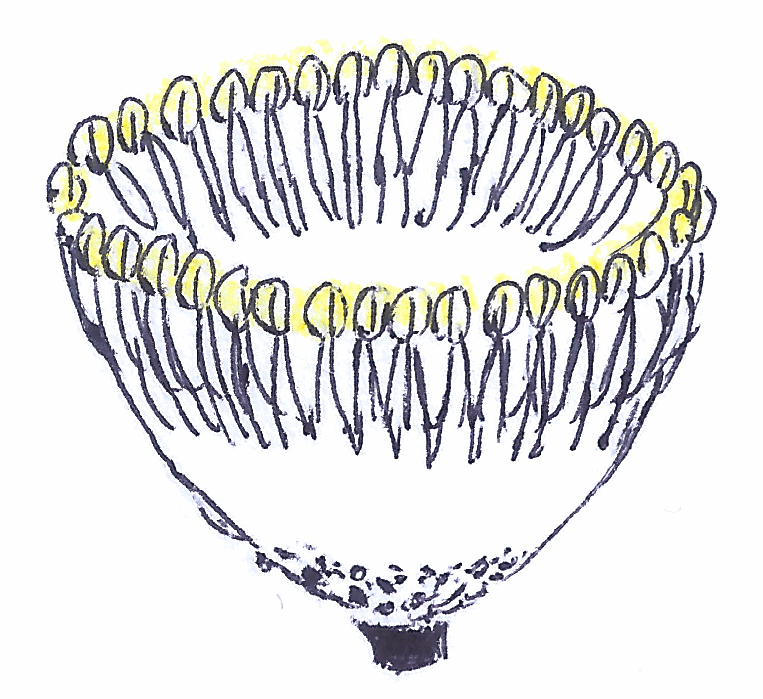
輪芯 Washin Circle Stamen
The stamens are all thick and short, and line up
regularly in a ring.
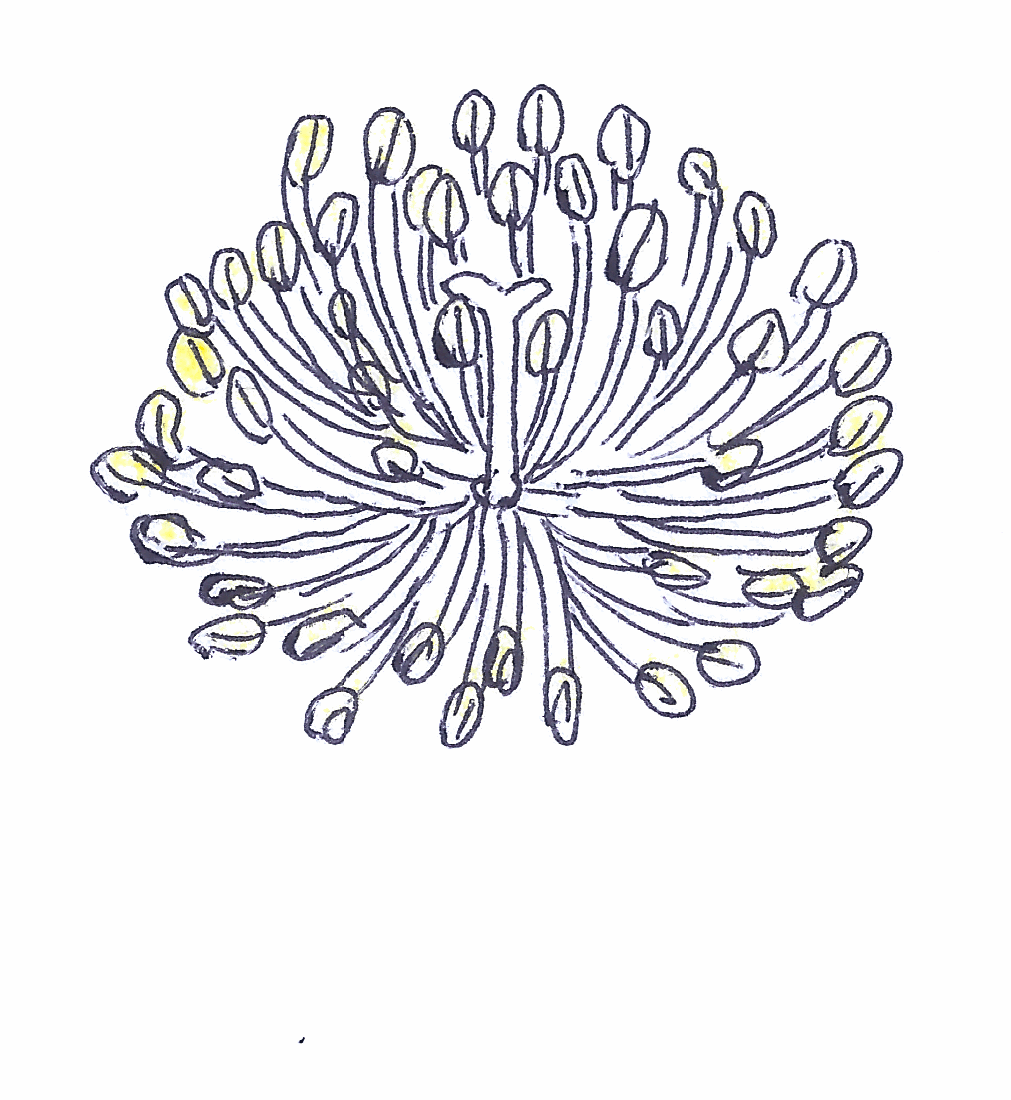 梅
芯 Baishin Plum Stamen 梅
芯 Baishin Plum Stamen
Especially typical of the Higo variety of
Camellia. Thick and long filaments radiate outward
over the entire center of the flower. Camellias
originating from Kumamoto have especially thick
filaments, which are sometimes called moyashi
[bean sprout] stamens.
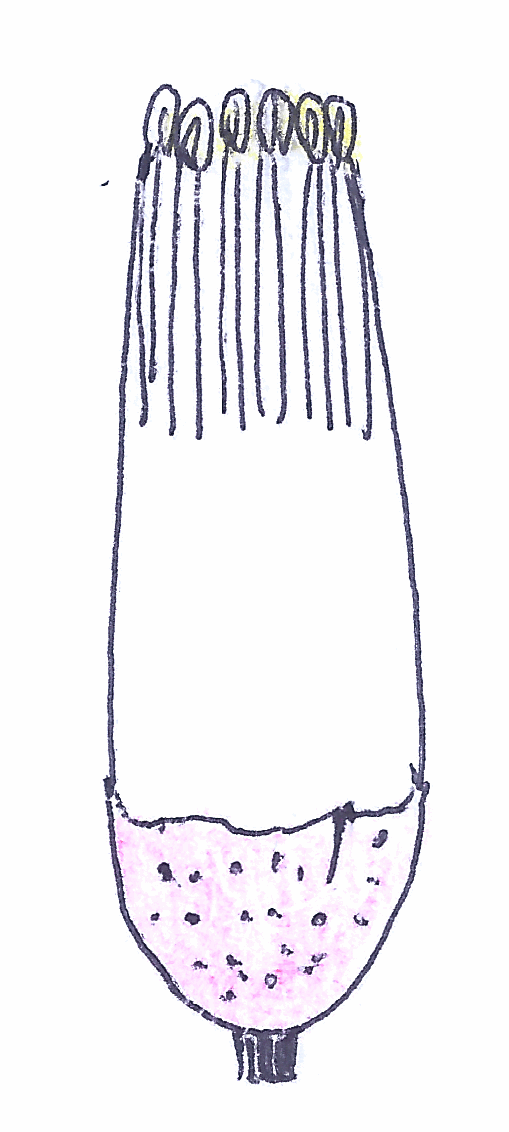
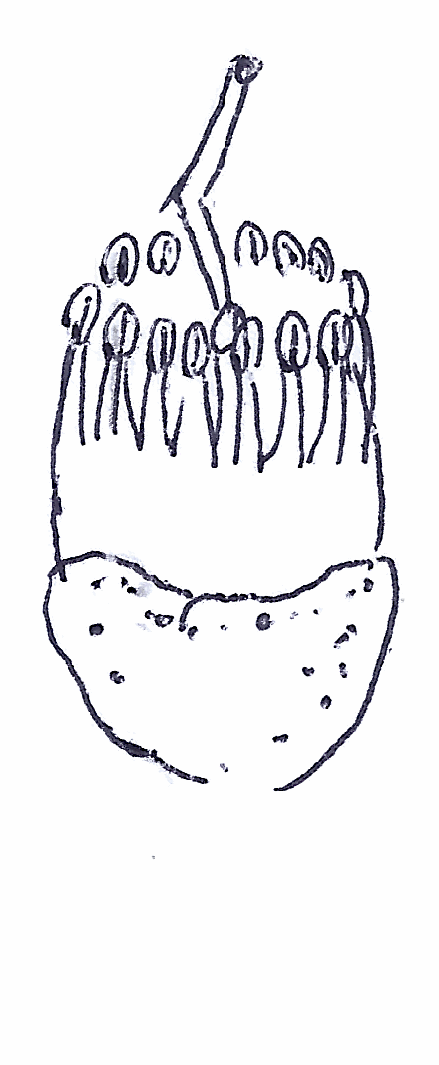
侘芯 Wabishin Wabi Stamen
The stamens of both Yabutsubaki and Yukitsubaki
mutate easily within the single petal variety. As
the stamen distorts, the flower itself becomes
smaller, and its blooming time earlier.
LEAVES
Leaves and flowers have an integral
relationship. Leaves give life to the flowers. For
camellia trees, the correlation between the shape
of the leaf and the shape of the flower is
especially noticeable. For example, the plump,
cup-blooming Kamo Hon'ami has round and wide
leaves. The diminutive, funnel-blooming Ikkyū has
very narrow and small leaves. Such complementarity
highlights the beauty of the flower. The
connection is so close it may almost be said that
even without the presence of the flower, one could
identify a camellia by its leaf alone.
By all means, go to your garden and
look closely at the camellia leaves. Avoid the
delicate leaves in the shade. Look for sturdy
branches and then to the third leaf from the tip.
The following criteria are what to notice.
1. The shape of the leaf
| |
 |
| |
a. 広楕円形
|
Hiro daenkei
|
Wide Elliptical
|
|
| |
b. 楕円形
|
Daenkei
|
Elliptical
|
|
| |
c. 長楕円形
|
Naga daenkei
|
Long Elliptical
|
|
| |
d. 卵状楕円形
|
Ranjō daenkei
|
Oval Elliptical
|
|
| |
e. 倒卵状
|
Sakasa ranjō
|
Inverted Oval
|
|
| |
f. 技針形
|
Hishinkei
|
Needle shape
|
|
2. The curvature of the leaf
| |
 |
| |
a. 平坦
|
Heitan
|
Level
|
| |
b. 葉縁が外曲
|
Hafuchiga Gaikyoku
|
Leaf edge bending outward
|
| |
c. 波曲
|
Hakyoku
|
Wave-like curve
|
| |
d. 中折れ
|
Nakaore
|
Bending upwards from the
middle
|
| |
e. 反曲
|
Hankyoku
|
Inverse bending
|
3. The veins of the leaf
Distinct, sunken, or raised. This is an important
step in the appraisal of the leaf. For example,
the net-like veins in the leaves of the Saga
Camellia are strikingly sunken, while those of the
Shiratama Camellia are shallow and indistinct.
4. The quality of serration
on the leaf edge and of the stem
Is the serration of the leaf edge rough, fine,
pointed, or barely noticeable. As for the stem
which attaches to the branch, is it long or short?
Another distinguishing characteristic between the
Yabutsubaki and the Yukitsubaki is whether or not
the stem has fine hairs on both sides.
| |

|
Yabutsubaki
Species of Camellia
The leaf edge is gently serrated in a
wavelike pattern and is not pointed. The
veins have a net-like pattern and are
faint. The stem is long and hairless.
|
| |
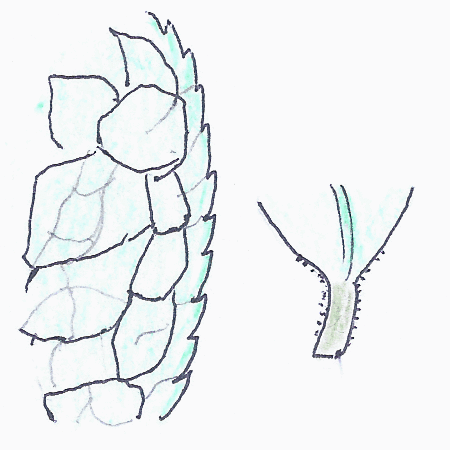
|
Yukitsubaki
Species of Camellia
The veins also have a net-like pattern
but are very clear and distinct. The
serration of the leaf edge is sharp and
pointed. The stem is short and edged
with short hairs.
|
Outside Japan it is difficult to
come by any of these many named varieties of
camellia. The discussion above of all the
distinguishing characteristics is not intended to
imply one must collect rare species. Rather it is
to alert the mind and the eye to the beauty of
each camellia one encounters. Knowing to pay
attention to the blooming form, the petal scenery,
the interior stamens, the leaves, will greatly
increase the pleasure one receives from the
flower, whether as host or guest, and becomes a
vocabulary with which to express appreciation of
winter chabana. Numerous Japanese books illustrate
the rich variety of blooming camellias. Looking
through the book's photographs to try to identify
a particular camellia growing nearby is great fun,
and the name often adds a poetic dimension to
discussion of winter chabana. It is enough to say,
this camellia looks a great deal like the [for
example, Showa Wabisuke] to me. We particularly
recommend Tankosha Publishing's Nihon
no Tsubaki Hana 日本の椿花 [new edition ISBN
978-4-473-03277-5]. Another good resource
for those in North America looking for chanoyu
camellias is Nuccio's
Nurseries in Altadena, California. The
printed catalogue contains many more varieties
than those listed online and may be ordered there.
Be prepared for the next winter season in the
tearoom!
Painted camellia
pictures by Nagai Sokei Sensei 永井宗圭 from No ni
saku chabana zufu 野に咲く茶花図譜.
Line drawings by Sokei
Miyamoto 宮本宗惠.

|